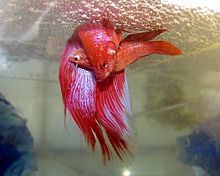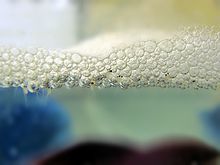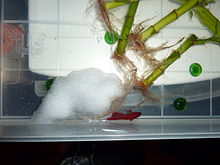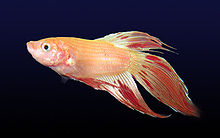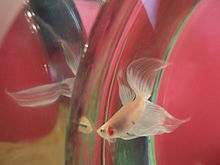- Siamese fighting fish
-
Siamese fighting fish 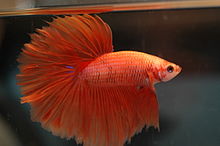
Selectively bred halfmoon male 
Naturally occurring female Conservation status DomesticatedScientific classification Kingdom: Animalia Phylum: Chordata Class: Actinopterygii Order: Perciformes Family: Osphronemidae Genus: Betta Species: B. splendens Binomial name Betta splendens
Regan, 1910The Siamese fighting fish (Betta splendens,
 /ˈbɛtə/), also known as the betta (particularly in the US[citation needed]), is a popular species of freshwater aquarium fish. The name of the genus is derived from ikan bettah, taken from a local dialect of Malay.[1] The wild ancestors of this fish are native to the rice paddies of Thailand, Malaysia and Cambodia and are called pla-kad in Thai or trey krem in Khmer.
/ˈbɛtə/), also known as the betta (particularly in the US[citation needed]), is a popular species of freshwater aquarium fish. The name of the genus is derived from ikan bettah, taken from a local dialect of Malay.[1] The wild ancestors of this fish are native to the rice paddies of Thailand, Malaysia and Cambodia and are called pla-kad in Thai or trey krem in Khmer.Contents
Description
B. splendens usually grow to an overall length of about 5 cm. Although known for their brilliant colors and large, flowing fins, the natural coloration of B. splendens is a dull green and brown, and the fins of wild specimens are relatively short. Brilliantly colored and longer finned varieties (i.e. Veiltail; Delta; Superdelta; and Halfmoon) have been developed through selective breeding.
Properly kept and fed a correct diet, B. Splendens live approximately 2–5 years in captivity.
The fish is a member of the gourami family (family Osphronemidae) of order Perciformes, but was formerly classified among the Anabantidae. Although there are nearly 50 other members of the Betta genus, B. splendens is one of the most popular species among aquarium hobbyists.
History
The people of Siam (now Thailand) originally started collecting these fish, Known as "pla kat," which means tearing or biting fish, prior to the 19th century.
In the wild, bettas spar for only a few minutes or so before one fish backed off. Bred specifically for fighting, domesticated betta matches would go on for much longer, with winners determined by a willingness to continue fighting. Once one fish retreated the match was over. Large amounts would be wagered on these fights, with potential losses as great as a person's home.
Seeing the popularity of these fights, the King of Siam started licensing and collecting these fighting fish. In 1840, he gave some of his prized fish to a man who, in turn, gave them to Dr. Theodor Cantor, a medical scientist. Nine years later, Dr. Cantor wrote an article describing them under the name Macropodus Pugnax. In 1909, Mr. Tate Regan realized that there was already a species with the name Macropodus Pugnax, and renamed the Siamese fighting fish to Betta splendens.[2]
Diet
Siamese fighting fish have upturned mouths and are primarily carnivorous surface feeders, although some vegetable matter may be eaten. In the wild, they feed on zooplankton including crustaceans and the larvae of mosquitoes and other insects, such as flies, crickets, or grasshoppers.[citation needed] Typically, commercial betta pellets are a combination of mashed shrimp meal, wheat flour, fish meal, brine shrimp, bloodworms, and vitamins. These fish will also eat live or frozen bloodworms, mosquito larvae, brine shrimp or daphnia.
Reproduction and early development
Male bettas flare their gills, twist their bodies, and spread their fins if interested in a female. The female will darken in color, then curve her body back and forth as a response. Males build bubble nests of various sizes and thicknesses at the surface of the water. The act of spawning itself is called a "nuptial embrace", for the male wraps his body around the female; around 10–41 eggs are released during each embrace, until the female is exhausted of eggs. The male, in his turn, releases milt into the water, and fertilization takes place externally. During and after spawning, the male uses his mouth to retrieve sinking eggs and deposit them in the bubble nest (during mating the female sometimes assists her partner, but more often she will simply devour all the eggs that she manages to catch). Once the female has released all of her eggs, she is chased away from the male's territory, as it is likely that she'll eat the eggs due to hunger.[3] The eggs remain in the male's care. He carefully keeps them in his bubble nest, making sure none fall to the bottom, repairing the bubble nest as needed. Incubation lasts for 24–36 hours; newly-hatched larvae remain in the nest for the next 2–3 days until their yolk sacs are fully absorbed. Afterwards the fry leave the nest and the free-swimming stage begins. It is common practice in the aquarium hobby to remove the male at this point, so that he would not eat his young (although it has been suggested that this danger is overrated). In this first period of their lives, B. splendens fry are totally dependent on their gills; the labyrinth organ which allows the species to breathe atmospheric oxygen typically develops at 3 to 6 weeks of age, depending on the general growth rate, which can be highly variable. B. splendens can reach sexual maturity at an age as early as 3 months.
B. splendens can be hybridized with B. imbellis, Betta sp. Mahachai and B. smaragdina, though with the latter the fry tend to have low survival rates. As well as these hybrids within the Betta genus, there have been reports of the inter generic hybridizing of Betta splendens and Macropodus opercularis- the Paradise Fish.
Colors
B. splendens have been affectionately nicknamed "The Jewel of the Orient" due to their beauty and wide range of colors which are produced through selective breeding[citation needed].
Wild fish exhibit strong colors only when agitated.[citation needed] Breeders have been able to make this coloration permanent, and a wide variety of hues breed true. Colors available to the aquarist include red,tangerine, blue, turquoise, orange, yellow, green, bright blue with pink highlights, cream and even true white (the "Opaque" white, not to be confused with albino). The shades of blue, turquoise and green are slightly iridescent, and can appear to change color with different lighting conditions or viewing angles; this is because these colors (unlike black or red) are not due to pigments, but created through refraction within a layer of translucent guanine crystals. Breeders have also developed different color patterns such as marble and butterfly, as well as metallic shades like copper, gold, or platinum (these were obtained by crossing B. splendens to other Betta species).
Breeders around the world continue to develop new varieties. Often, the male of the species are sold preferentially in stores because of their beauty, compared to the females. Recently, breeders have developed in females the same range of colors previously only bred in males. Females never develop fins as showy as males of the same type and are often more subdued in coloration.
The true albino betta has been feverishly sought after since one recorded appearance in 1927, and another in 1953. Neither of these were able to establish a line of true albinos. In 1994, a hobbyist named Tanaka claimed to have successfully bred albino bettas. [4]
Finnage and scale variations
Breeders have developed several different finnage and scale variations:
- Veiltail (extended finnage length and non-symmetrical tail; caudal fin rays usually only split once)
- Crowntail (fin rays are extended well beyond the membrane and consequently the tail can take on the appearence of a crown; also called fringetail)
- Combtail (less extended version of the crown tail, derived from breeding crown and another finnage type)
- Half-moon (caudal fin that forms a 180-degree spread; larger spreads are dubbed over half-moon)
- Short-finned fighting style (sometimes called "plakat")
- Double-tail (the tail fin is duplicated into two lobes and the dorsal fin is significantly elongated; the two tails can show different levels of bifurcation depending on the individual)
- Delta tail (tail spread less than that of a half-moon with sharp edges)
- Halfsun (Combtail with caudal fin going 180 degrees, like a halfmoon)
- Rosetail (halfmoon variation with so much finnage that it overlaps and looks like a rose)
- Dragon Scale (scales which are solid rich color; colors tend to be mostly white)
Behavior
Males and females flare or puff out their gill covers (opercula) in order to appear more impressive, either to intimidate other rivals or as an act of courtship. Other reasons for flaring their gills is that they are startled by movement or change of scene in their environment. Both sexes will display horizontal bars (unless they are too light a color for this to show) if stressed or frightened; however, such a color change, common in females of any age, is very rare in mature males. Females often flare their gills at other females, especially when setting up a pecking order. Flirting fish behave similarly, with vertical instead of horizontal stripes indicating a willingness and readiness to breed (females only). In fact king Bettas flare their fins and gills as a sign of aggression or flirting with other fish. Bettas sometimes require a place to hide, even in the absence of threats. They may set up a territory centered on a plant or rocky alcove, sometimes becoming highly possessive of it and aggressive toward trespassing rivals.
On average, males are more aggressive. The aggression of this fish has been studied by ethologists and comparative psychologists.[5] Siamese fighting fish will even respond aggressively to their own reflections in a mirror; use of a mirror avoids the risk of physical damage inherent in actual conflict, although it can lead to stress in some individuals. Like other fish, the fighter may respond to the presence of humans and become trained to respond to feeding cues (such as a hand placed over the water's surface). They are quite curious and will watch humans going about their business nearby. When plant leaves reach the surface, they are useful for males to base their bubble nests on. Ethical issues are still debated with the growing activity of pitting males together. Audience bet on the fishes while the bettas savagely attack each other. Males are isolated from one another to avoid such aggression.
Tanks and tank mates
In captivity, male B. splendens are best housed alone[6] since, as their name "fighting fish" implies, they will aggressively attack and kill (or be killed by) another male in their territory. Putting female and male specimens together is not recommended either (except for breeding, in which the female should be removed immediately after the process) as they will often attack each other. Female bettas can sometimes be kept together in groups of three to 8 in larger tanks with hiding places for the less-aggressive females. Male bettas have been successfully housed in large community tanks with other fish that have similar tropical temperature and water quality requirements. Platies, corycats, and african dwarf frogs work the best with this fish. Bettas might harass and nip at other species that are colorful or have long, flowing fins, and may be nipped at by aggressive tank mates. Careful research should be carried out before selecting tank mates.[7] Although many retail pet shops market very small "bowls" for B. splendens and the fish can, in fact, survive in a small container for periods of time, for optimum health and vigor larger tanks should be considered. A commonly accepted minimum tank volume is 4 to 5 litres. [8]
In popular culture
- In the 1963 James Bond movie From Russia with Love, the strategy of the criminal organization SPECTRE is compared to three Siamese fighting in the same tank: Two will fight each other to the death while the third will wait its turn to fight the exhausted victor, symbolizing the conflict between the USA and the Soviet Union, with SPECTRE as the fish that waits.
- The title of S.E. Hinton's 1975 novel Rumble Fish, is an eponymous reference to what two brothers call the breed. In Francis Ford Coppola's 1983 film adaptation, everything appears in black and white except the Siamese fighting fish.
- The Siamese fighting fish has been used as the default background in the beta and release candidate versions of the 2009 Windows 7 operating system, in an apparent reference to the name "Betta." A similar wallpaper and boot-screen also used in the pre-releases of Windows 8.
- A Siamese fighting fish features as a clue in a murder in 2009 film Bad Lieutenant: Port of Call New Orleans.
- Milo and his brother Oscar, two of the main characters in the Disney Channel's 2010 series, Fish Hooks, are half betta fish.
References
- ^ Froese, Rainer, and Daniel Pauly, eds. (2006). Species of Betta in FishBase. March 2006 version.
- ^ "Betta Origins". Betta Fish Center. http://www.bettafishcenter.com/Betta-Origins.shtml. Retrieved 11 June 2011.
- ^ Leong, Paul (2004). Tips on Spawning Bubblenesting Bettas. Retrieved on March 13, 2009.
- ^ Albino image
- ^ Bronstein, Paul M. (1998). "Agonistic Sequences and the Assessment of Opponents in Male Betta splendens". American Journal of Psychology 265 (2): 163–177. JSTOR 1422809.
- ^ Betta Caresheet. UltimateBettas (2011-07-25). Retrieved on 2011-08-01.
- ^ Tankmates for Bettas | Betta Fish Care. Nippyfish.net (2009-12-23). Retrieved on 2011-08-01.
- ^ Choosing a Tank | Betta Fish Care. Nippyfish.net (2011-02-06). Retrieved on 2011-08-01.
Further reading
- Simpson, M. J. A. (1968). The display of the Siamese fighting fish Betta splendens. Animal Behaviour Monographs, 1, 1–73.
- Thompson, T. (1966). Operant and Classically-Conditioned Aggressive Behavior in Siamese Fighting Fish. American Zoologist, 6, 629–741 doi:10.1093/icb/6.4.629.
External links
- Bettas at the Open Directory Project
- "Betta splendens". Integrated Taxonomic Information System. http://www.itis.gov/servlet/SingleRpt/SingleRpt?search_topic=TSN&search_value=172611. Retrieved 19 March 2006.
- Froese, Rainer, and Daniel Pauly, eds. (2005). "Betta splendens" in FishBase. November 2005 version.
Categories:- Domesticated animals
- Betta
- Fish of Southeast Asia
- Fishkeeping
- Fish of Thailand
Wikimedia Foundation. 2010.

